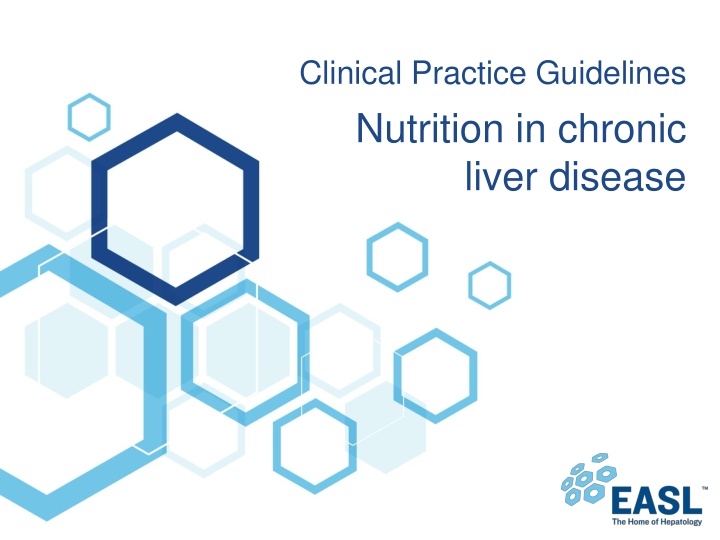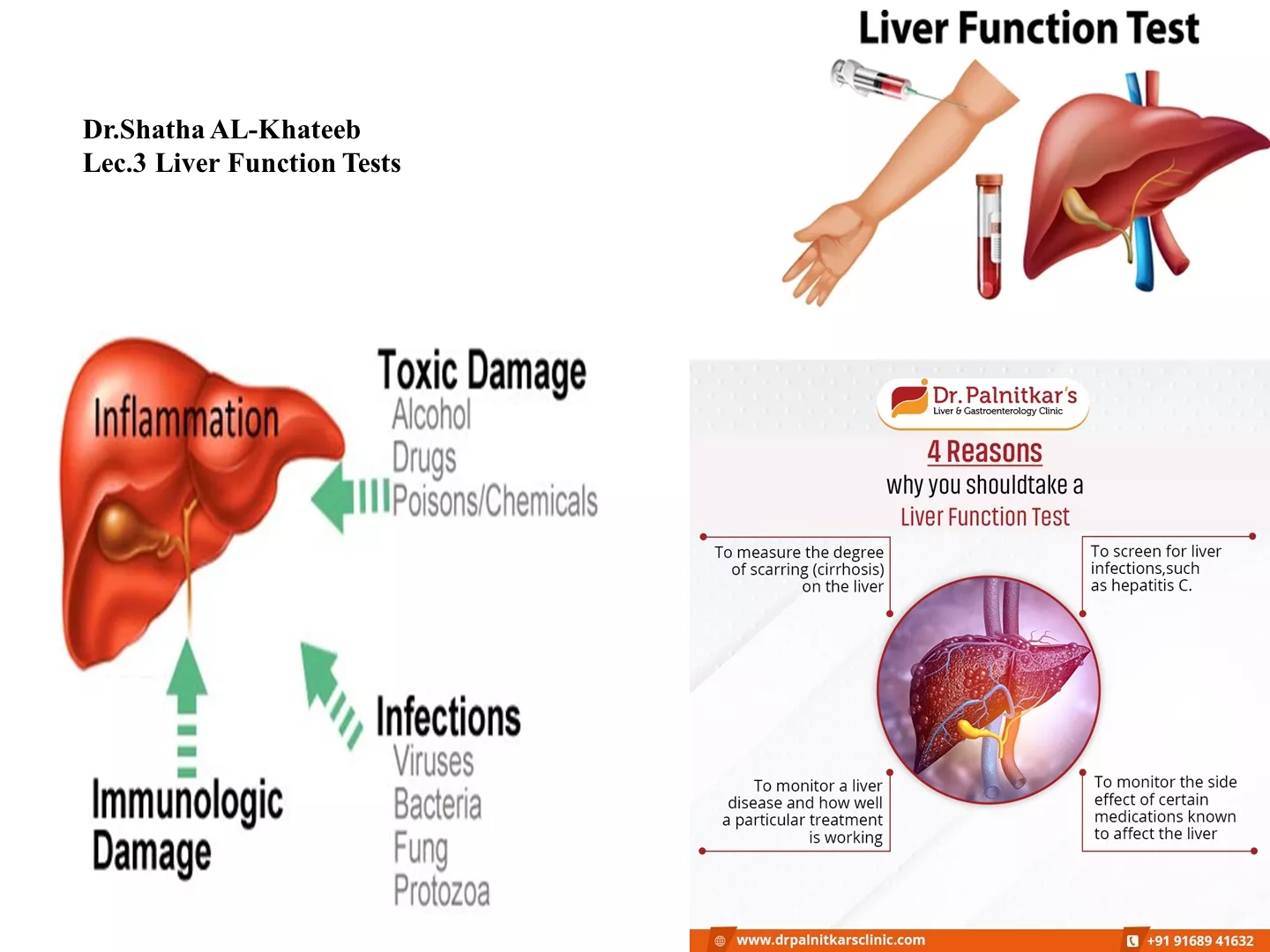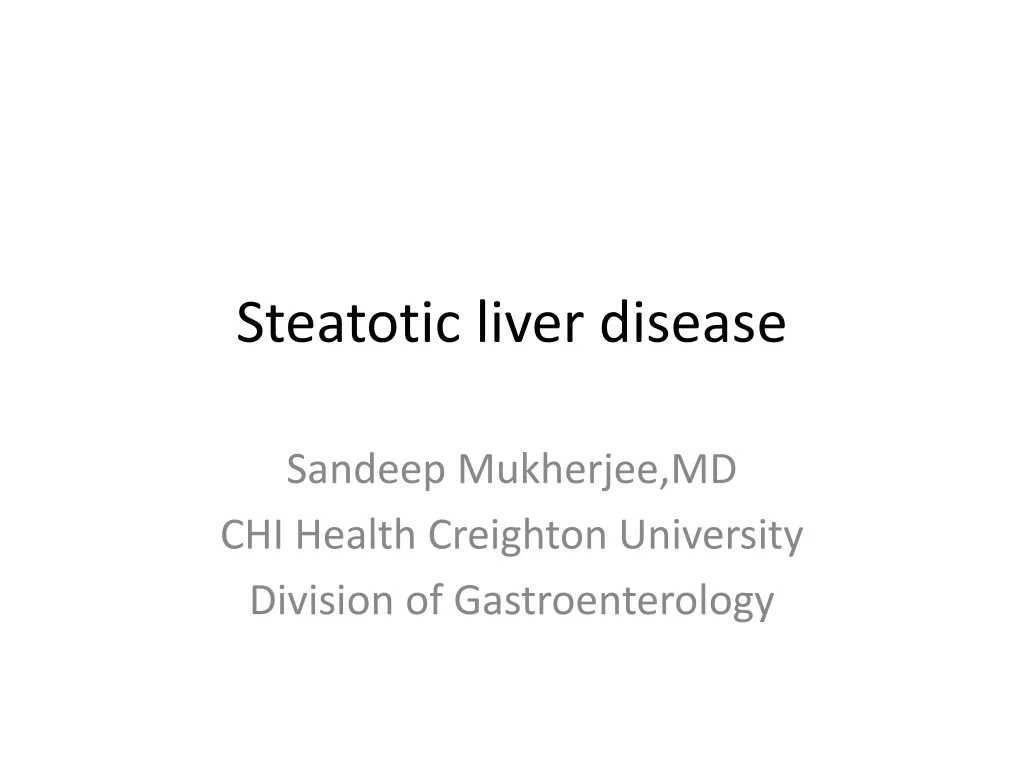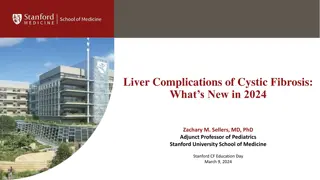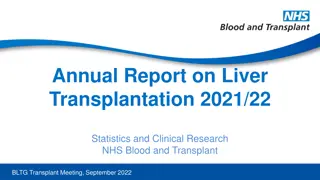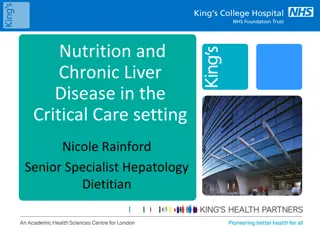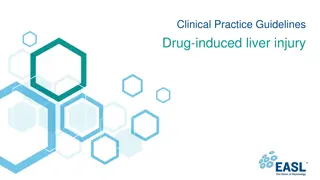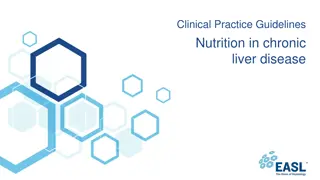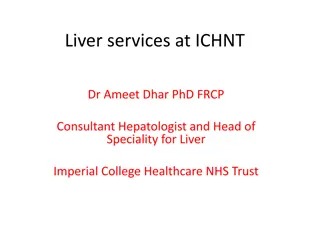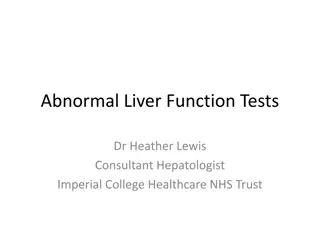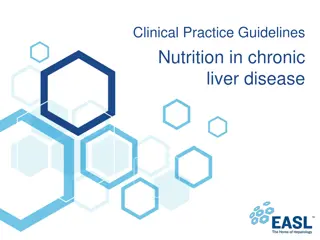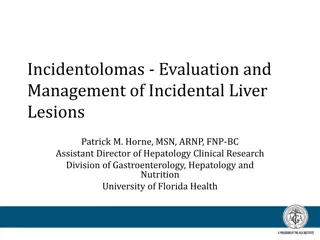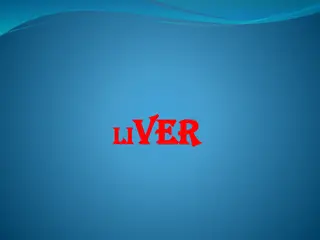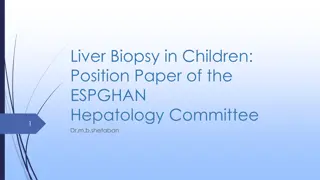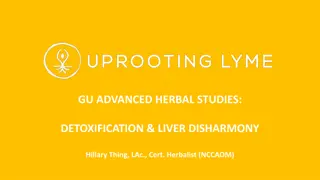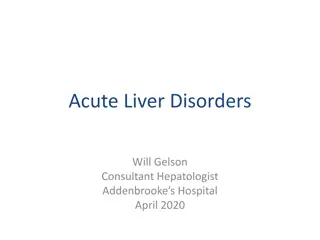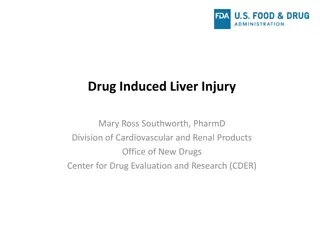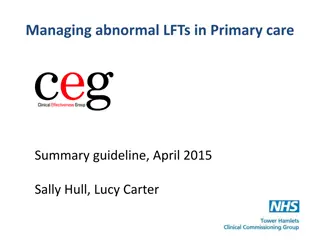EASL Clinical Practice Guidelines: Nutrition in Chronic Liver Disease Overview
These slides provide a detailed overview of the EASL clinical practice guidelines on nutrition in chronic liver disease, first presented at the International Liver Congress 2018. The guidelines cover key recommendations, grading evidence, and unresolved issues in patient management. The content is intended as an educational resource, emphasizing the importance of verifying information before implementing therapies.
Download Presentation

Please find below an Image/Link to download the presentation.
The content on the website is provided AS IS for your information and personal use only. It may not be sold, licensed, or shared on other websites without obtaining consent from the author.If you encounter any issues during the download, it is possible that the publisher has removed the file from their server.
You are allowed to download the files provided on this website for personal or commercial use, subject to the condition that they are used lawfully. All files are the property of their respective owners.
The content on the website is provided AS IS for your information and personal use only. It may not be sold, licensed, or shared on other websites without obtaining consent from the author.
E N D
Presentation Transcript
Clinical Practice Guidelines Nutrition in chronic liver disease
About these slides These slides give a comprehensive overview of the EASL clinical practice guidelines on nutrition in chronic liver disease The guidelines were first presented at the International Liver Congress 2018 and are published in the Journal of Hepatology The full publication can be downloaded from the Clinical Practice Guidelines section of the EASL website Please feel free to use, adapt, and share these slides for your own personal use; however, please acknowledge EASL as the source
About these slides Definitions of all abbreviations shown in these slides are provided within the slide notes When you see a home symbol like this one: , you can click on this to return to the outline or topics pages, depending on which section you are in These slides are intended for use as an educational resource and should not be used in isolation to make patient management decisions. All information included should be verified before treating patients or using any therapies described in these materials Please send any feedback to: slidedeck_feedback@easloffice.eu
Guideline panel Chair Manuela Merli Panel members Shira Zelber-Sagi, Srinivasan Dasarathy, Sara Montagnese, Laurence Genton, Mathias Plauth, Albert Par s, Annalisa Berzigotti (EASL Governing Board Representative) Reviewers Dominique Valla, Stephan Bischoff, Puneeta Tandon ADD CPG FRONT PAGE IMAGE HERE EASL CPG nutrtition in chronic liver disease. J Hepatol 2018; doi: 10.1016/j.jhep.2018.06.024
Outline Methods Grading evidence and recommendations Methodology Grading evidence and recommendations Methodology Methods Background Present knowledge Background Present knowledge Guidelines Key recommendations Guidelines Key recommendations The future Unresolved issues The future Unresolved issues EASL CPG nutrtition in chronic liver disease. J Hepatol 2018; doi: 10.1016/j.jhep.2018.06.024
Methods Grading evidence and recommendations Methodology
Grading evidence and recommendations Grading is adapted from the GRADE system1 Level of evidence I Randomized, controlled trials II-1 Controlled trials without randomization II-2 Cohort or case-control analytical studies II-3 Multiple time series, dramatic uncontrolled experiments III Opinions of respected authorities, descriptive epidemiology Evidence quality A High: Further research is very unlikely to change our confidence in the estimated effect B Moderate: Further research is likely to have an important impact on our confidence in the estimated effect and may change the estimate C Low: Further research is likely to have an important impact on our confidence in the estimated effect and is likely to change the estimate. Any change of estimate is uncertain Grade of recommendation 1 Strong: Factors influencing the strength of the recommendation included the quality of the evidence, presumed patient-important outcomes, and costs 2 Weak: Variability in preferences and values, or more uncertainty. Recommendation is made with less certainty: higher costs or resource consumption 1. EASL CPG nutrtition in chronic liver disease. J Hepatol 2018; doi: 10.1016/j.jhep.2018.06.024 Guyatt GH, et al. BMJ 2008:336:924 6
Methodology 1. Questions to address were established Taking into account relevance, urgency and completeness of each Key questions addressed In which conditions are nutritional assessments recommended? What are the consequences of malnutrition and its correction? How can nutritional problems be recognized? What are the available methods of evaluation? 2. Literature search PubMed, Embase, Google Scholar, Scopus Initial key words: nutrition OR nutritional status OR malnutrition OR sarcopenia AND liver cirrhosis OR chronic liver disease Specific key words: nutritional assessment , nutrition risk , hepatic encephalopathy , osteoporosis , liver transplantation 3. References selected based on appropriateness of study design, number of patients, and publication in peer-reviewed journals Original data were prioritized EASL CPG nutrtition in chronic liver disease. J Hepatol 2018; doi: 10.1016/j.jhep.2018.06.024
Background Malnutrition definition The burden of malnutrition in cirrhosis
Malnutrition definition The term malnutrition can refer both to deficiencies and to excesses in nutritional status However, in the present guideline, malnutrition is used as a synonym of undernutrition only In addition to cirrhotic patients with undernutrition, overweight or obese patients with cirrhosis are increasingly being seen, due to the increased number of cirrhosis cases related to NASH Muscle mass depletion may also occur in these patients, but due to the coexistence of obesity, sarcopenia might be overlooked Malnutrition, obesity and sarcopenic obesity may worsen the prognosis of patients with cirrhosis EASL CPG nutrtition in chronic liver disease. J Hepatol 2018; doi: 10.1016/j.jhep.2018.06.024
Prevalence and implications of malnutrition and sarcopenia in cirrhosis Malnutrition is a frequent burden in cirrhosis In 20% of patients with compensated cirrhosis In >50% of patients with decompensated cirrhosis1 Progression of malnutrition is associated with progression of liver failure May be less evident in compensated cirrhosis Easily recognizable in patients with decompensated cirrhosis Both adipose tissue and muscle tissue can be depleted In female patients, depletion of fat deposits is more frequent In men, loss of muscle tissue is more rapid1,2 1. Italian multicentre cooperative project on nutrition in liver cirrhosis. J Hepatol 1994;21:317 25; 2. Caregaro L, et al. Am J Clin Nutr 1996;63:602 9 EASL CPG nutrtition in chronic liver disease. J Hepatol 2018; doi: 10.1016/j.jhep.2018.06.024
Prevalence and implications of malnutrition and sarcopenia in cirrhosis Malnutrition and muscle mass loss (sarcopenia), which is often used as an equivalent of severe malnutrition,1 associate with complications:2 Susceptibility to infections Hepatic encephalopathy Ascites Independent predictors of lower survival in cirrhosisand in patients undergoing liver transplantation Malnutrition and sarcopenia should be recognized as complications of cirrhosis that worsen the prognosis of patients General agreement that these patients dietary intake needs to improve Whether malnutrition can be reversed in patients with cirrhosis is unclear 1. Dasarathy S, et al. J Cachexia Sarcopenia Muscle 2012;3:225 37; 2. Huisman EJ, et al. Eur J Gastroenterol Hepatol 2011;23:982 9 EASL CPG nutrtition in chronic liver disease. J Hepatol 2018; doi: 10.1016/j.jhep.2018.06.024
Relationship between malnutrition, complications of cirrhosis, transplantation, and survival Decompensated cirrhosis Malnutrition and/or sarcopenia Hepatic encephalopathy Bacterial infections Recurrent ascites Reduced overall survival In HCC: increased complications and reduced survival After surgery: reduced survival In liver transplantation: Increased waiting list mortality and post-operative complications Tandon P, et al. Hepatology 2017;65:1044 5 EASL CPG nutrtition in chronic liver disease. J Hepatol 2018; doi: 10.1016/j.jhep.2018.06.024
Guidelines Key recommendations
Topics 1. 2. 3. 4. 5. 6. 7. Screening and assessment for malnutrition and obesity in cirrhosis Nutritional management principles in patients with cirrhosis Approach to sarcopenia in patients with cirrhosis Approach and management of obesity in patients with cirrhosis Micronutrients Nutritional treatment options for hepatic encephalopathy Nutritional treatment options in patients with cirrhosis and bone disease Clinical scenarios requiring special considerations The future for nutrition in chronic liver disease 8. 9. N.B. these guidelines refer specifically to adult patients with cirrhosis EASL CPG nutrtition in chronic liver disease. J Hepatol 2018; doi: 10.1016/j.jhep.2018.06.024
Screening for malnutrition in cirrhosis As malnutrition is associated with worse prognosis, all patients with advanced chronic liver disease, especially decompensated cirrhosis, should undergo a rapid nutritional screen Two criteria stratify patients at high risk of malnutrition: Being underweight (BMI <18.5 kg/m2) Advanced decompensated cirrhosis(Child Pugh C) Grade of evidence Grade of recommendation Recommendations Perform a rapid nutritional screen in all patients with cirrhosis and complete a detailed assessment in those at risk of malnutrition to confirm the presence and severity of malnutrition Assume malnutrition risk is high if BMI <18.5 kg/m2 or Child Pugh C. In all other cases, utilize nutritional screening tools to assess risk of malnutrition II-2 B 1 II-2 B 1 All patients at risk of malnutrition should undergo detailed nutritional assessment by a registered dietician or nutrition expert EASL CPG nutrtition in chronic liver disease. J Hepatol 2018; doi: 10.1016/j.jhep.2018.06.024
Detailed nutritional assessment In patients at high risk of malnutrition, assess each component every 1 6 months in the outpatient setting and for inpatients, at admission and periodically throughout the hospital stay:1 Muscle mass and sarcopenia Direct quantification of skeletal muscle mass via CT image analysis at the L3 vertebra (only when CT is available as being performed for other reasons) Body mass assessment via anthropometric methods* Bone mineral density, fat mass and fat-free mass via DEXA Limb non-fat mass quantification via tetrapolar BIA Sarcopenia indicated by impaired skeletal muscle contractile function; via handgrip strength Subjective global assessment (SGA) uses clinical evaluation data to determine nutritional status without objective measurements Includes the Royal Free Hospital-global assessment (RFH-GA)2 Patient-reported dietary intake *Including mid-arm muscle circumference (MAMC), mid-arm muscular area (MAMA) and triceps skinfold (TSF) 1. Tandon P, et al. Hepatology 2017;65:1044 57; 2. Morgan MY, et al. Hepatology 2006;44:823 35 EASL CPG nutrtition in chronic liver disease. J Hepatol 2018; doi: 10.1016/j.jhep.2018.06.024
Detailed nutritional assessment Grade of evidence Grade of recommendation Recommendations Include an assessment of sarcopenia within the nutritional assessment Assess muscle mass by CT imaging where available (having been performed for other purposes). Anthropometry, DEXA or BIA are possible alternatives, which also allow serial measurements Assess muscle function in the clinical setting with the most appropriate tools, such as handgrip strength (HGS) and/or the short physical performance battery (SPPB) Assessment of dietary intake by trained personnel (ideally a dietician with knowledge of managing patients with liver disease) working as part of a team with the hepatologist. Assessment should include: quality and quantity of food and supplements, fluids, sodium in diet, number and timing of meals during the day and barriers to eating II-2 B 1 II-2 B 1 II-2 B 1 II-2 B 1 EASL CPG nutrtition in chronic liver disease. J Hepatol 2018; doi: 10.1016/j.jhep.2018.06.024
Nutritional screening and assessment in patients with cirrhosis: Summary Cirrhosis/advanced chronic liver disease Calculate Child Pugh score Assess whether fluid retention Estimate dry weight if needed* Child C Child A or B Underweight <18.5 kg/m2 BMI Obesity 30 kg/m2 18.5 29.9 kg/m2 Screen for malnutrition Utilize nutritional screening tools Nutritional assessment + lifestyle intervention in compensated cirrhosis/ACLD Consider assessing sarcopenia + Follow-up re-screen at least 1/year High risk Medium risk Low risk Assess sarcopenia Consider CT scan to measure muscle area at L3 Consider DEXA or BIA if no fluid retention Detailed nutritional assessment (expert dietician) Subjective global assessment (SGA) Royal Free Hospital-global assessment (RFH-GA) Reported dietary intake Sarcopenia Malnutrition No malnutrition Treat: Nutrition supplementation and appropriate follow-up (repeat assessment every 1 3 months in first year) *In the case of fluid retention, body weight should be corrected by evaluating the patient s dry weight by post-paracentesis body weight or weight recorded before fluid retention if available, or by subtracting a percentage of weight based upon severity of ascites (mild, 5%; moderate, 10%; severe, 15%), with an additional 5% subtracted if bilateral pedal oedema is present. EASL CPG nutrtition in chronic liver disease. J Hepatol 2018; doi: 10.1016/j.jhep.2018.06.024
Nutritional screening and assessment in patients with cirrhosis: Summary Cirrhosis/advanced chronic liver disease Calculate Child Pugh score Assess whether fluid retention Estimate dry weight if needed* Child C Child A or B Underweight <18.5 kg/m2 BMI Obesity 30 kg/m2 18.5 29.9 kg/m2 Sedentary lifestyle is highly prevalent in patients with cirrhosis and might be seen as Screen for malnutrition Utilize nutritional screening tools a cofactor Nutritional assessment + lifestyle intervention in compensated cirrhosis/ACLD Consider assessing sarcopenia + Follow-up re-screen at least 1/year High risk Medium risk Low risk Assess sarcopenia Consider CT scan to measure muscle area at L3 Consider DEXA or BIA if no fluid retention Detailed nutritional assessment (expert dietician) Subjective global assessment (SGA) Royal Free Hospital-global assessment (RFH-GA) Reported dietary intake Sarcopenia Malnutrition No malnutrition Treat: Nutrition supplementation and appropriate follow-up (repeat assessment every 1 3 months in first year) *In the case of fluid retention, body weight should be corrected by evaluating the patient s dry weight by post-paracentesis body weight or weight recorded before fluid retention if available, or by subtracting a percentage of weight based upon severity of ascites (mild, 5%; moderate, 10%; severe, 15%), with an additional 5% subtracted if bilateral pedal oedema is present. EASL CPG nutrtition in chronic liver disease. J Hepatol 2018; doi: 10.1016/j.jhep.2018.06.024
Nutritional management principles in cirrhosis: Energy and protein requirements Cirrhosis is a state of accelerated starvation characterized by a rapid post-absorptive physiology and reduced respiratory quotient Protein synthesis is decreased and gluconeogenesis from amino acids increased, necessitating proteolysis, which contributes to sarcopenia Energy supply needs to balance total energy expenditure (TEE) Most interventions aim for 35 kcal/kg.BW/day* Grade of evidence Grade of recommendation Recommendations Performance of nutritional counselling in patients with malnutrition and cirrhosis by a multidisciplinary team to help the patient achieve adequate calorie and protein intake Optimal daily energy intake should not be lower than the recommended 35 kcal/kg actual BW/day (in non-obese individuals) Optimal daily protein intake should not be lower than the recommended 1.2 1.5 g/kg actual body weight/day Include late evening oral nutritional supplementation (ONS) and breakfast in the dietary regimen of malnourished patients with decompensated cirrhosis II-2 C 2 II-2 B 1 II-2 B 1 II-1 B 1 *Use of actual BW corrected for ascites is considered safe EASL CPG nutrtition in chronic liver disease. J Hepatol 2018; doi: 10.1016/j.jhep.2018.06.024
Practical advice for patients Healthy eating of a variety of foods is advisable for all patients With the exception of alcohol, virtually no food damages the liver and is genuinely contraindicated in patients with chronic liver disease In most cases eating adequate calories and protein is much more important than avoiding specific types of food It is important that patients have a good, varied diet that they enjoy Food intake should be split Three main meals: breakfast, lunch and dinner Three snacks: Mid-morning, mid-afternoon, late evening Late-evening snack is the most important EASL CPG nutrtition in chronic liver disease. J Hepatol 2018; doi: 10.1016/j.jhep.2018.06.024
Practical advice for patients Fruit and vegetables should always be included in the diet Salt should be restricted Patients should report reduced food intake as a result of this advice to their doctor or dietician Some patients with liver disease may have hepatic encephalopathy May tolerate animal proteins less well than vegetable and dairy proteins Patients should always consult a doctor or dietician before altering their protein intake Patients with concomitant disease* may require dietary adjustments Patients should report any coexisting condition or previous dietary advice *For example diabetes or obesity EASL CPG nutrtition in chronic liver disease. J Hepatol 2018; doi: 10.1016/j.jhep.2018.06.024
Practical advice for patients As many fruit and vegetables as possible should be eaten Salt should be restricted Patients should report reduced food/protein intake as a result of this advice to their doctor or dietician Some patients with liver disease may have hepatic encephalopathy May tolerate animal proteins less well than vegetable and dairy proteins advisable in cirrhosis A reduction in total protein intake is not Patients should always consult a doctor or dietician before altering their protein intake Patients with concomitant disease* may require dietary adjustments Patients should report any coexisting condition or previous dietary advice *For example diabetes or obesity EASL CPG nutrtition in chronic liver disease. J Hepatol 2018; doi: 10.1016/j.jhep.2018.06.024
Mechanisms resulting in sarcopenia and failure to respond to standard supplementation Anabolic resistance and dysregulated proteostasis result in sarcopenia and/or failure to respond to standard supplementation These mechanisms represent potential therapeutic targets Figure adapted from Dasarathy S. Curr Opin Gastroenterol 2016;32:159 65 EASL CPG nutrtition in chronic liver disease. J Hepatol 2018; doi: 10.1016/j.jhep.2018.06.024
Approach to sarcopenia in patients with cirrhosis Skeletal muscle mass is the largest protein store in the body Depends on age, gender, ethnicity, severity/aetiology of liver disease Adequate calorie and protein intake can be difficult to achieve in malnourished patients with sarcopenia and advanced liver disease Limited but consistent data suggest supplemental nutrition improves quality of life if it results in increased lean body mass1 Despite potential adverse effects, a combination of resistance and endurance exercise is likely to be appropriate and beneficial2 1. Maharshi S, et al. Clin Gastroenterol Hepatol 2016;14:454 60; 2. Berzigotti A, et al. Hepatology 2017;65:1293 305 EASL CPG nutrtition in chronic liver disease. J Hepatol 2018; doi: 10.1016/j.jhep.2018.06.024
Potential management approaches to sarcopenia: Oral supplements Supplemental calories/ protein/amino acids Grade of evidence Grade of recommendation Recommendations In patients with malnutrition and cirrhosis who are unable to achieve adequate dietary intake with the oral diet (even with oral supplements), a period of enteral nutrition is recommended II-1 B 1 Figure adapted from Dasarathy S. Curr Opin Gastroenterol 2016;32:159 65 EASL CPG nutrtition in chronic liver disease. J Hepatol 2018; doi: 10.1016/j.jhep.2018.06.024
Potential management approaches to sarcopenia: BCAA supplements and anaplerotic agents BCAA supplements Anaplerotic agents Grade of evidence Grade of recommendation Recommendations BCAA supplements and leucine-enriched amino acid supplements should be considered in patients with decompensated cirrhosis when adequate nitrogen intake is not achieved by oral diet II-1 C 1 Figure adapted from Dasarathy S. Curr Opin Gastroenterol 2016;32:159 65 EASL CPG nutrtition in chronic liver disease. J Hepatol 2018; doi: 10.1016/j.jhep.2018.06.024
Potential management approaches to sarcopenia: Exercise Structured exercise programme Grade of evidence Grade of recommendation Recommendations Avoid hypomobility in patients with cirrhosis whenever possible, and progressively increase physical activity to prevent and/or ameliorate sarcopenia II-1 C 2 Figure adapted from Dasarathy S. Curr Opin Gastroenterol 2016;32:159 65 EASL CPG nutrtition in chronic liver disease. J Hepatol 2018; doi: 10.1016/j.jhep.2018.06.024
Potential management approaches to sarcopenia: other approaches Transplantation Hormone replacement Aromatase inhibitors Ammonia-lowering therapy Myostatin antagonists Mitoprotective agents Antibiotics Zinc-gut permeability Figure adapted from Dasarathy S. Curr Opin Gastroenterol 2016;32:159 65 EASL CPG nutrtition in chronic liver disease. J Hepatol 2018; doi: 10.1016/j.jhep.2018.06.024
Obesity in cirrhosis: Assessment and interpretation A sedentary lifestyle is highly prevalent in patients with cirrhosis, increasing obesity risk, but obesity does not rule out malnutrition Obesity is present in most cases of NASH-related cirrhosis Sarcopenic obesity describes loss of skeletal muscle/gain of adipose tissue and is observed in patients with cirrhosis Estimate and treat malnutrition routinely in obese patients with cirrhosis (BMI >30 kg/m2 in absence of fluid retention) Grade of evidence Grade of recommendation Recommendations In the diagnosis of obesity (BMI >30 kg/m2) always consider the confounding effect of fluid retention. Estimate dry body weight, although accuracy is low II-2 B 2 EASL CPG nutrtition in chronic liver disease. J Hepatol 2018; doi: 10.1016/j.jhep.2018.06.024
Nutritional management principles in cirrhosis: Approach and management of obesity Multiple studies suggest a reduction in body weight improves outcomes in obese patients with compensated cirrhosis1 3 Weight loss can be achieved by nutritional therapy and supervised moderate-intensity physical exercise tailored to the patient s ability Grade of evidence Grade of recommendation Recommendations Implement a nutritional and lifestyle programme to achieve progressive weight loss ( 5 10%) in obese patients with cirrhosis (BMI >30 kg/m2 corrected for water retention) Adopt a tailored, moderately hypocaloric (-500 800 kcal/day) diet, including an adequate amount of protein (>1.5 g protein/kg ideal BW/day) to achieve weight loss without compromising protein stores in obese patients with cirrhosis II-2 C 1 II-1 C 2 1. Zenith L, et al. Clin Gastroenterol Hepatol 2014;12:e1922; 2. Everhart JE, et al. Gastroenterology 2009;137:549 57; 3. Macias-Rodriguez RU, et al. Clin Transl Gastroenterol 2016;7:e180 EASL CPG nutrtition in chronic liver disease. J Hepatol 2018; doi: 10.1016/j.jhep.2018.06.024
Micronutrients Vitamin deficiencies in liver disease are generally related to hepatic dysfunction and diminished reserves Inadequate dietary intake and malabsorption increase with disease severity Serum 25(OH)D concentrations in patients with cirrhosis, stratified by Child Pugh score in four individual studies1 4 A Child Pugh score B Crawford, et al.1 Fisher, et al.2 Chen, et al.3 Putz-Bankuti, et al.4 C 0 10 20 30 40 Vitamin D (ng/ml) 1. Crawford BAL, et al. Osteoporos Int 2003;14:987 94; 2. Fisher L, et al. Clin Gastroenterol Hepatol 2007;5:513 20; 3. Chen CC, et al. J Gastroenterol Hepatol 1996;11:417 21; 4. Putz-Bankuti C, et al. Liver Int 2012;32:845 51 EASL CPG nutrtition in chronic liver disease. J Hepatol 2018; doi: 10.1016/j.jhep.2018.06.024
Micronutrients A majority of liver disease patients considered for liver transplantation present with vitamin A and D deficiencies Vitamin D levels <20 ng/ml are reported in chronic cholestatic conditions, and often inversely correlate with disease severity and Child Pugh score Vitamin D also correlates with treatment response in HCV, NAFLD and patients who develop HCC Grade of evidence Grade of recommendation Recommendations In patients with cirrhosis, administer micronutrients and vitamins to treat confirmed or clinically suspected deficiency Assess vitamin D levels in patients with cirrhosis as deficiency is highly prevalent and may adversely affect clinical outcomes Supplement vitamin D orally in patients with cirrhosis and vitamin D levels <20 ng/ml, to reach serum vitamin D (25(OH)D) >30 ng/ml II-1 C 1 II-3 B 1 II-1 B 1 EASL CPG nutrtition in chronic liver disease. J Hepatol 2018; doi: 10.1016/j.jhep.2018.06.024
Micronutrients Hyponatraemia is common in patients with cirrhosis, and more likely when sodium intake is low with water unchanged or increased. Careful monitoring of sodium and water intake is required Confirmed or clinically suspected micronutrient deficiencies should be treated based on accepted general recommendations and common practice Grade of evidence Grade of recommendation Recommendations In patients with cirrhosis and ascites under sodium restriction (recommended intake of sodium ~80 mmol day = 2 g of sodium corresponding to 5 g of salt added daily to the diet according to EASL guidelines) take care to improve diet palatability as this may cause a reduction in calorie intake II-2 B 1 EASL CPG nutrtition in chronic liver disease. J Hepatol 2018; doi: 10.1016/j.jhep.2018.06.024
Nutritional treatment options for hepatic encephalopathy (HE) HE is more common in malnourished patients with cirrhosis Inverse relationship between muscle mass and blood ammonia levels Hyperammonaemia may impair muscle function and contribute to muscle loss1 Patients with cirrhosis and HE have the same energy requirements as those without HE Although dysregulated nitrogen metabolism plays a key role in HE development, nitrogen requirements are the same as patients without HE Grade of evidence Grade of recommendation Recommendations Nutritional status and sarcopenia should be evaluated in patients with HE Avoid protein restriction in patients with HE Optimal daily protein and energy intake should not be lower than the general recommendations for patients with cirrhosis Encourage the consumption of vegetables and dairy protein BCAA supplementation should be considered to improve neuropsychiatric performance and to reach the recommended nitrogen intake Oral dietary intake is preferred in patients who can tolerate it. In patients with grade III IV encephalopathy who are unable to eat, provide nutrition by nasogastric tube (in patients with protected airways) or parenterally II-3 B II-1 A 1 1 II-1 A 1 II-3 B 1 I-1 A 1 II-1 B 1 1. McDaniel J, et al. Am J Physiol Gastrointest Liver Physiol 2016;310:G163 70 EASL CPG nutrtition in chronic liver disease. J Hepatol 2018; doi: 10.1016/j.jhep.2018.06.024
Nutritional treatment options in patients with cirrhosis and bone disease risk factors ~30% patients with chronic liver disease, and 30% eligible for liver transplantation have osteoporosis, with higher prevalence in cholestasis Characterized by loss of bone mass and quality, causing fragility fractures Risk factors for osteoporosis in chronic liver disease Family history of osteoporotic fracture Male hypogonadism Alcohol abuse Treatment with corticosteroids* Smoking Advanced age BMI <19 kg/m2 Secondary amenorrhoea >6 months Early menopause * 5 mg/d prednisone for 3 months EASL CPG nutrtition in chronic liver disease. J Hepatol 2018; doi: 10.1016/j.jhep.2018.06.024
Nutritional treatment options in patients with cirrhosis and bone disease diagnosis According to the WHO, bone densitometry of the lumbar spine and hip is the gold standard for diagnosis of osteoporosis and osteopenia Should be evaluated in: Patients with previous fragility fractures Those treated with corticosteroids Before liver transplantation In cholestatic diseases Patients with cirrhosis If any other risk factors are found Grade of evidence Grade of recommendation Recommendations Evaluate BMD in patients with cirrhosis, cholestatic liver disease, receiving long-term corticosteroid treatment, and before liver transplantation Utilize lumbar and femoral densitometry (DEXA) for diagnosing osteoporosis and osteopenia. Use lateral X-rays of dorsal and lumbar spine for diagnosing vertebral fractures Repeat DEXA after 2 3 years in patients within normal BMD, and within 1 year when rapid bone loss is expected II-2 A 1 II-3 A 1 II-1 B 1 EASL CPG nutrtition in chronic liver disease. J Hepatol 2018; doi: 10.1016/j.jhep.2018.06.024
Nutritional treatment options in patients with cirrhosis and bone disease treatment A balanced diet is recommended Including calcium and 25(OH)D supplements to preserve normal levels Physical activity is recommended Especially exercises to improve mechanics of the spine Factors that increase bone loss (alcohol, tobacco, corticosteroids etc.) should be minimized Although studies are limited, bisphosphonates* are reported to increase bone mass in patients with PBC with no serious adverse events1,2 Grade of evidence Grade of recommendation Recommendations Include supplements of calcium (1,000 1,500 mg/day) and 25(OH)D (400 800 IU/day or 260 g every 2 weeks) in patients with chronic liver disease and a T-score below -1.5 Utilize bisphosphonates in patients with cirrhosis and osteoporosis, and in those waiting for liver transplantation Consider testosterone supplementation and venesection in males with haemochromatosis and hypogonadism II-3 A 1 I A 1 II-2 B 1 *Including etidronate, alendronate, and ibandronate 1. Guanabens N, et al. Am J Gastroenterol 2003;98:2268 74; 2. Guanabens N, et al. Hepatology 2013;58:2070 8 EASL CPG nutrtition in chronic liver disease. J Hepatol 2018; doi: 10.1016/j.jhep.2018.06.024
Diagnosis and management of bone disease in patients with chronic liver disease summary Diagnosis Management DEXA Treatment Bone densitometry (DEXA) of lumbar spine and hip Repeat in 2 3 years Normal T-score >-1.5 Ca + 25(OH)D* Lateral X-rays of dorsal and lumbar spine Repeat in 1 2 years Osteopenia T-score -1.5 and >-2.5 Ca + 25(OH)D* Bisphosphonates Laboratory measurements to identify abnormal calcium and vitamin D metabolism Repeat in 1 year Osteoporosis T-score -2.5 Ca + 25(OH)D* Bisphosphonates New agents *Calcium (1,000 1,500 mg/d) and 25-hydroxy-vitamin D (400 800 IU/day or 260 g every 2 weeks) to preserve normal levels; According to the severity of liver disease and cholestasis, and in patients taking corticosteroids; Depending on additional risk factors EASL CPG nutrtition in chronic liver disease. J Hepatol 2018; doi: 10.1016/j.jhep.2018.06.024
Malnutrition in patients undergoing liver surgery and liver transplantation preoperative nutrition Patients with severe undernutrition* or obesity undergoing liver surgery have higher risk of morbidity and mortality Waiting list patients are also at risk due to inadequate food or caloric intake Liver glycogen is depleted in patients with cirrhosis Periods without nutrient intake should be reduced Grade of evidence Grade of recommendation Recommendations Screen for malnutrition and sarcopenia in patients with cirrhosis listed for LT or scheduled for elective surgery. Treat sarcopenia prior to elective surgery, to enable improvement in body protein status and clinical outcomes Screen for sarcopenic obesity with body composition analysis in obese patients with cirrhosis considered for surgery If treatment goal is maintenance of nutritional status, plan: Total energy intake 30 kcal/kg.BW/day and protein intake 1.2 g/kg.BW/day If treatment goal is improvement of nutritional status, plan: Total energy intake 35 kcal/kg.BW/day and protein intake 1.5 g/kg.BW/day Utilize standard nutrition regimens. Specialized regimens (e.g. BCAA- enriched, immune-enhancing diets) have not been shown to improve morbidity or mortality III B 2 III C 2 II-3 B 1 II-1 B 1 *BMI <18.5 kg/m2; BMI >40 kg/m2 EASL CPG nutrtition in chronic liver disease. J Hepatol 2018; doi: 10.1016/j.jhep.2018.06.024
Malnutrition in patients undergoing liver surgery and liver transplantation postoperative nutrition Versus fluid and electrolytes only, post-operative nutrition decreases: Ventilator time Length of ICU stay Bacterial and viral infections Bile duct and other complications Grade of evidence Grade of recommendation Recommendations After LT, initiate normal food and/or enteral tube feeding within 12 24 hours, or as soon as possible, to reduce infection rates When oral or enteral nutrition are not possible, parenteral nutrition should be used over not feeding After the acute postoperative phase, provide an energy intake of 35 kcal/kg.BW/day and protein intake of 1.5 g/kg.BW/day After other surgical procedures, manage patients with chronic liver disease according to ERAS protocols Consider parenteral nutrition in patients with unprotected airways and HE when cough and swallow reflexes are compromised, or enteral nutrition is contraindicated or impractical II-2 B 1 II-2 B 1 II-2 C 1 III C 2 II-2 C 1 EASL CPG nutrtition in chronic liver disease. J Hepatol 2018; doi: 10.1016/j.jhep.2018.06.024
Malnutrition in patients undergoing liver surgery and liver transplantation postoperative nutrition Patients remain in negative nitrogen balance after LT Necessitates an increase in protein or amino acid provision Nutrition improves nitrogen economy in non-transplant visceral surgery Chronic dilutional hyponatraemia should be carefully corrected after LT to avoid pontine myelinolysis Long-term LT survivors risk weight gain/obesity due to metabolic syndrome Stringent physiotherapy and dietary counselling should be used Grade of evidence Grade of recommendation Recommendations In obese patients, utilize enteral tube feeding and/or parenteral nutrition with a reduced target energy intake (25 kcal/kg ideal BW*/day) and an increased target protein intake (2.0 g/kg ideal BW*/day) III C 2 *Ideal body weight as calculated based on height and gender EASL CPG nutrtition in chronic liver disease. J Hepatol 2018; doi: 10.1016/j.jhep.2018.06.024
Malnutrition in critically ill patients with cirrhosis Critically ill patients include those: Hospitalized for severe complications of chronic liver disease With acute-on-chronic liver failure In an ICU With acute alcoholic hepatitis Grade of evidence Grade of recommendation Recommendations Consider nutritional status and presence of sarcopenia. Provide nutritional support while treating other manifestations of severe decompensation Daily energy intake should not be lower than 35 40 kcal/kg.BW/day, or 1.3x measured REE Daily protein intake should not be lower than 1.2 1.3 g/kg.BW/day II-3 C 1 II-2 B 1 II-2 B 1 EASL CPG nutrtition in chronic liver disease. J Hepatol 2018; doi: 10.1016/j.jhep.2018.06.024
Malnutrition in critically ill patients with cirrhosis Direct measurement of REE by indirect calorimetry is advisable As in all critically ill patients, tight glucose control is indicated Enteral or parenteral nutrition is more likely to be required Grade of evidence Grade of recommendation Recommendations Supplement dietary intake by enteral nutrition in patients unable to achieve adequate intake by mouth. If oral diet or enteral nutrition are not tolerated or contraindicated, provide parenteral nutrition Utilize standard nutrition regimens. Specialized regimens (e.g. BCAA- enriched, immune-enhancing diets) have not been shown to improve morbidity or mortality In patients with HE, consider BCAA-enriched solutions III A 1 II-1 B 2 I A 1 EASL CPG nutrtition in chronic liver disease. J Hepatol 2018; doi: 10.1016/j.jhep.2018.06.024
Malnutrition and other special considerations Alcoholic liver disease and severe/acute alcoholic hepatitis Patients with active alcohol abuse may have a higher REE Gastrointestinal bleeding Withhold enteral nutrition for 48 72 hours after acute bleeding due to risk of increased portal pressure and variceal re-bleeding Grade of evidence Grade of recommendation Recommendations Naso-gastroenteric tubes are not contraindicated in patients with non-bleeding oesophageal varices Avoid PEG insertion in patients with cirrhosis due to risk of bleeding In cirrhosis and severe/acute alcoholic hepatitis, provide nutritional support as it may accelerate resolution of hepatic encephalopathy and improve survival in patients with low calorie intake II-2 A 1 III B 2 II-1 A 1 EASL CPG nutrtition in chronic liver disease. J Hepatol 2018; doi: 10.1016/j.jhep.2018.06.024
The future for nutrition in chronic liver disease
New research should address the following topics Nutritional strategies: Does the improvement in muscle mass and/or muscle function improve clinical outcomes (reduced risk of first decompensation, ascites, infection and encephalopathy, hospital readmissions or falls, decreased length of hospital stay, improved survival)? Do ammonia-lowering strategies in decompensated cirrhosis reverse muscle loss and improve clinical outcomes? Does a gradual increase in physical activity delay or reverse muscle loss and contractile dysfunction? What type and duration of exercise is beneficial in patients with cirrhosis? Is the addition of supplements (leucine, isoleucine, or other nutrient supplements) needed to lower ammonia and increase mitochondrial intermediates during training? How to implement therapies targeting muscle protein synthesis pathways or dysregulated muscle autophagy How to overcome anabolic resistance or reverse the underlying causes of anabolic resistance in patients with cirrhosis EASL CPG nutrtition in chronic liver disease. J Hepatol 2018; doi: 10.1016/j.jhep.2018.06.024
New research should address the following topics In patients with bone diseases: The use and safety of anabolic drugs such as PTH 1 34 and denosumab as potential new therapies for osteoporosis in patients with cirrhosis In patients with special considerations: In the absence of indirect calorimetry, what is the best way to calculate energy needs in critically ill patients with liver diseases? Does increased energy and protein intake improve outcomes in critically ill patients with liver diseases? Should nutritional recommendations differ according to the patient s nutritional status at baseline? EASL CPG nutrtition in chronic liver disease. J Hepatol 2018; doi: 10.1016/j.jhep.2018.06.024
